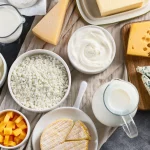
A balanced diet
What are the 5 food groups?
A healthy diet does not need to be complicated. Eat foods from the 5 food groups every day. The 5 food groups are:
- vegetables and legumes (beans)
- fruit
- grains and cereals
- lean meat, poultry, fish, eggs, legumes (beans), tofu, nuts, seeds
- milk, cheese, yoghurt or alternatives
Each food group has important nutrients.
The amount of each food you need will vary during your life. Your diet will depend on factors such as:
- how active you are
- whether or not you are growing
- whether or not you are pregnant or breastfeeding
Why should I eat vegetables and legumes (beans and peas)?
Vegetables and legumes are rich in nutrients such as:
- vitamins
- minerals
- dietary fibre
To get the most nutrition, make sure you choose:
- vegetables that are in season
- fresh, frozen or canned vegetables
- different coloured vegetables:
- greens like beans, peas, spinach, brussels sprouts and broccoli
- red, orange, or yellow vegetables like capsicums, tomatoes, carrots, sweet potato, and pumpkin
- purple vegetables like red cabbage and eggplant
- white vegetables like cauliflower, mushrooms and potatoes
How many vegetables and legumes should I eat?
| Life stage | Number of serves |
| 2 to 3 year-olds | 2½ serves a day |
| 4 to 8 year-olds | 4½ serves a day |
| people aged 9 years and over | 5 – 6 serves a day |
| pregnant people | 5 serves a day |
| breastfeeding people | 7½ serves a day |
One serve of vegetables and legumes is equal to:
- ½ cup, cooked vegetables and legumes
- 1 cup, raw vegetables and legumes
You can include vegetables at lunch as well as dinner, by eating:
- raw veggies
- salad
- soup
- roasted vegetables on sandwiches or in salads
Cherry tomatoes, snow peas, green beans, red capsicum, celery, or carrot sticks with hummus make a great snack.
Why should I eat fruit?
Fresh fruit is a good source of vitamins, minerals and dietary fibre.
How much fruit should I eat?
| Life stage | Number of serves |
| 2 to 3 year-olds | 1 serve a day |
| 4 to 8 year-olds | 1½ serves a day |
| people over 9 years | 2 serves a day |
A single serve of fruit is one of the following:
- 1 piece of medium-sized fruit
- 2 pieces of small-sized fruit
- ½ cup (125ml) of 100% fruit juice
- 1 cup of diced, cooked, or canned fruit
- 30g of dried fruit
If you want to have fruit juice, drink it only occasionally. Half a cup (125ml) is enough. Fruit juices without pulp lack fibre. Commercial fruit juices are often high in sugars, which can damage your tooth enamel.
If you choose to eat canned fruit, choose options that are canned in water or natural juice. Dried fruit also has a high sugar content. It is only suitable as an occasional extra.
Why should I eat grains and cereal foods?
Grain and cereal foods include rolled oats, brown rice, wholemeal and wholegrain breads, cracked wheat, barley, buckwheat, and breakfast cereals. Wholegrain foods are better for you because they have more fibre and vitamins.
How much grains and cereals should I eat?
| Life stage | Number of serves |
| 2 to 8 year-olds | start with 4 serves a day |
| 9 to 11 year-olds | 4 – 5 serves a day |
| 12 to 13 year-olds | 5 – 6 serves |
| 14 to 18 year-olds | 7+ serves |
| adults | 3 – 6 serves a day |
| pregnant people | 8½ serves a day |
| breastfeeding people | 9 serves a day |
A serve is one of the following:
- 1 slice of bread
- ½ cup cooked rice, oats, pasta, or other grain
- 3 rye crispbread
- 30g of breakfast cereal (⅔ cup flakes or ¼ cup muesli)
Why should I eat lean meat, poultry, fish, eggs, legumes (beans), tofu, nuts, and seeds?
These foods contain protein, minerals, and vitamins. Legumes, nuts, and seeds also have dietary fibre. It’s good to choose a variety of foods from this group. Oily fish such as salmon and mackerel are very healthy. It is recommended that you eat these twice per week.
How much protein should I eat?
| Life stage | Number of serves |
| 2 to 3 year-olds | 1 serve a day |
| 4 to 8 year-olds | 1½ serves a day |
| 9 to 18 year-olds | 2½ serves a day |
| males | 2½ – 3 serves a day |
| females | 2 – 2½ serves |
| pregnant people | 3½ serves a day |
| breastfeeding people | 2½ serves a day |
A serve is one of the following:
- 65g cooked red meat
- 80g poultry
- 100g fish
- 2 eggs
- 1 cup legumes
- 170g tofu
- 30g nuts, seeds, or pastes (peanut butter or tahini)
Why should I eat milk, cheese and yoghurt?
Dairy products give you protein, vitamins, and calcium.
Children should have full-cream milk until they are 2 years old. Reduced-fat varieties may be suitable after that.
Soy drinks with added calcium can be used as a milk substitute for children over one year.
Some other plant-based alternatives to milk, such as nut or oat milks, have added calcium. However, they can lack vitamin B12 and enough protein. Check your child’s total diet with a doctor or qualified dietitian before using them.
Read more on introducing allergy foods to babies and children on Pregnancy, Birth and Baby.
How much dairy products should I eat?
| Life stage | Number of serves |
| 2 to 3 year-olds | 1 – 1½ serves a day |
| 4 to 8 year-olds | 1½ – 2 serves a day |
| 9 to 18 year-olds | 2½ – 3½ serves a day |
| males | 2½ – 3½ serves a day |
| females | 2½ – 4 serves a day |
| females over 51 years | 4 serves a day |
| pregnant and breastfeeding people | 2½ serves a day |
A serve is one of the following:
- 1 cup of milk
- 2 slices of cheese
- ¾ cup yoghurt
- 1 cup of calcium enriched plant-based milk
If you use plant-based alternatives to milk, check that they have at least 100mg calcium per 100mL.
What can I drink?
Apart from milk, the ideal drink for everyone is tap water.
What oils and spreads should I use?
You can eat small amounts of unsaturated oils and spreads. These may be from:
- olives
- soybeans
- corn
- canola
- sunflower
- safflower
- sesame
- grapeseeds
What about other foods?
Foods that are not included in the 5 food groups are called ‘discretionary choices’ or ‘extras’. Some of these could be called junk foods. These foods and drinks often provide excess energy, saturated fat, sugar, or salt. They are often described as ‘energy-rich but nutrient-poor’. They also often replace healthier foods in the diet.
Discretionary choices are not needed in a healthy diet. These foods include:
- alcohol
- biscuits
- cakes
- store bought burgers
- cordials, sports, fruit, and energy drinks
- fried foods
- hot chips
- ice blocks
- ice cream
- lollies and chocolates
- potato crisps
- processed meats
- savoury snack foods
- soft drinks




